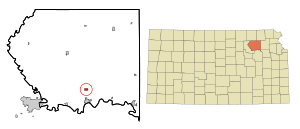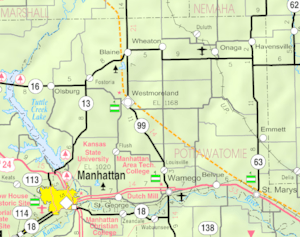Louisville, Kansas facts for kids
Quick facts for kids
Louisville, Kansas
|
|
|---|---|

Location within Pottawatomie County and Kansas
|
|

|
|
| Country | United States |
| State | Kansas |
| County | Pottawatomie |
| Founded | 1857 |
| Incorporated | 1870 |
| Named for | Louis Wilson and Louis Vieux |
| Area | |
| • Total | 0.50 sq mi (1.29 km2) |
| • Land | 0.50 sq mi (1.29 km2) |
| • Water | 0.00 sq mi (0.00 km2) |
| Elevation | 1,011 ft (308 m) |
| Population
(2020)
|
|
| • Total | 131 |
| • Density | 262/sq mi (101.6/km2) |
| Time zone | UTC-6 (CST) |
| • Summer (DST) | UTC-5 (CDT) |
| ZIP code |
66450
|
| Area code | 785 |
| FIPS code | 20-42925 |
| GNIS ID | 2395771 |
Louisville is a small city located in Pottawatomie County, Kansas, in the United States. In 2020, about 131 people lived there.
Contents
History of Louisville
Louisville was started in 1857 by Robert Wilson. He first called it Rock Post. This area was once a hunting ground for the Potawatomi Native American tribe. Many early settlers were connected to the Pottawatomie Indian Reservation. Others were involved in trade along the famous Oregon Trail.
The city was named after Robert Wilson's son, Louis. It was also named after Louis Vieux, a successful local businessman. Louisville tried to become the main town, or county seat, of Pottawatomie County. However, it lost to St. George in 1861. Later, it lost again to Westmoreland in 1882.
On November 8, 1875, an earthquake shook Louisville. By 1882, the county seat was in Westmoreland. Also, the Union Pacific Railroad was built through Wamego, not Louisville. Because of these changes, the number of people living in Louisville quickly went down.
Louis Vieux: A Local Leader
Louis Vieux Sr. was an important person in Louisville's early days. He ran a crossing point over the Vermillion River. This helped travelers on the Oregon Trail. Louis Vieux was born in 1809 in Wisconsin. His mother, Angelique Roy, was a Potawatomi woman. His father, Jacques Vieux, was a French-Canadian trader.
In 1832, Vieux and his wife, Sha-Note, moved to Iowa. Later, in 1846, they moved to Indianola, Kansas. Sha-Note passed away in 1857. After that, Vieux moved near the Vermillion River, where Louisville is today.
Vieux started his river crossing business. He also worked for the U.S. Government at a pay station in St. Mary's. He was a member of the tribal council. He even traveled to Washington, D.C. to speak for the Pottawatomies. Vieux signed a treaty that divided the Pottawatomies into two groups. These were the Prairie Band and the Citizen Potawatomi Nation.
Louis Vieux died in 1872. He left a long will that gave half of Louisville and all of Belvue to his wife and children.
Oregon Trail Crossing Point
About three miles east of Louisville was the Vermillion Crossing. This was a key spot on the Oregon Trail. Louis Vieux managed this important river crossing. Vieux is buried in the Vieux Family Cemetery on a nearby hill.
Close by, on the riverbanks, is a cholera cemetery from 1849. It is thought to hold at least fifty graves. However, only two stone markers, made of local sandstone, are still there.
Across the river was the famous Louis Vieux Elm Tree. It was believed to be over 300 years old. Sadly, the tree suffered from Dutch elm disease, lightning strikes, and vandalism. People tried to protect its stump. But in August 2011, the stump was destroyed by fire. Near where the tree stood are the graves of seven unknown soldiers.
Geography of Louisville
Louisville is located in Kansas. You can find it between the cities of Wamego and Westmoreland. It sits right on K-99, a state highway.
The United States Census Bureau says that Louisville covers about 0.49 square miles (1.29 square kilometers). All of this area is land, with no large bodies of water.
Louisville's Population
| Historical population | |||
|---|---|---|---|
| Census | Pop. | %± | |
| 1860 | 135 | — | |
| 1870 | 344 | 154.8% | |
| 1880 | 432 | 25.6% | |
| 1890 | 382 | −11.6% | |
| 1900 | 336 | −12.0% | |
| 1910 | 246 | −26.8% | |
| 1920 | 207 | −15.9% | |
| 1930 | 227 | 9.7% | |
| 1940 | 188 | −17.2% | |
| 1950 | 190 | 1.1% | |
| 1960 | 204 | 7.4% | |
| 1970 | 204 | 0.0% | |
| 1980 | 207 | 1.5% | |
| 1990 | 215 | 3.9% | |
| 2000 | 209 | −2.8% | |
| 2010 | 188 | −10.0% | |
| 2020 | 131 | −30.3% | |
| U.S. Decennial Census | |||
Louisville is part of the larger Manhattan, Kansas Metropolitan Statistical Area. This means it's connected to the economy and community of Manhattan.
Population in 2020
The 2020 United States census counted 131 people living in Louisville. There were 57 households and 25 families. Most of the people, about 97%, were white. About 3% were from two or more races. Less than 1% of the population was Hispanic or Latino.
About 14% of households had children under 18. About 33% were married couples. Around 39% of households were made up of single individuals. About 14% of these individuals were 65 years old or older. The average household had 1.8 people.
About 14% of the population was under 18 years old. About 19% were 65 or older. The average age in Louisville was 46.8 years.
Population in 2010
In the census of 2010, Louisville had 188 people. There were 78 households and 39 families. The city's population density was about 384 people per square mile.
Most residents, about 92%, were White. About 1% were Native American. Around 4% were from other races. About 3% were from two or more races. About 6% of the population was Hispanic or Latino.
About 30% of households had children under 18. About 38% were married couples living together. Half of all households were not families. About 27% of households had just one person. About 10% of these were people aged 65 or older living alone.
The median age in the city was 34.5 years. About 23% of residents were under 18. About 11% were between 18 and 24. About 29% were between 25 and 44. About 26% were between 45 and 64. And about 11% were 65 or older. There were slightly more males (51.1%) than females (48.9%).
Education in Louisville
Students in Louisville attend schools in the Wamego USD 320 public school district.
See also
 In Spanish: Louisville (Kansas) para niños
In Spanish: Louisville (Kansas) para niños


